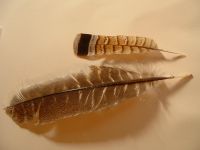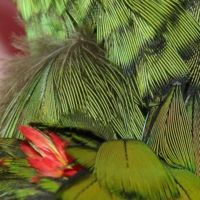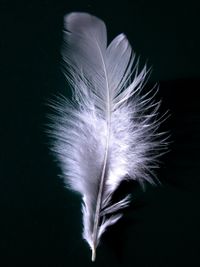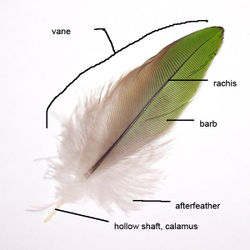
Two feathers
Feathers are one of the epidermal growths that
form the distinctive outer covering, or
plumage, on
birds. They are the outstanding characteristic that
distinguishes the Class
Aves from all other living groups. Other
Theropoda also had feathers.
Characteristics

Extreme closeup of the feathers of a baby
Yellow-headed Parrot.

A white feather
Feathers are among the most complex structural organs
found in vertebrates: integumentary appendages, formed by
controlled proliferation of cells in the epidermis, or outer
skin layer, that produce keratin proteins. The β-keratins in
feathers, beaks and claws — and the claws, scales and shells
of reptiles — are composed of protein strands
hydrogen-bonded into β-pleated sheats, which are then
further twisted and crosslinked by disulfide bridges into
structures even tougher than the α-keratins of mammalian
hair, horns and hoof.
Feathers insulate birds from water and cold temperatures.
Individual feathers in the wings and tail play important
roles in controlling flight. These have their own identity
and are not just randomly distributed. Some species have a
crest of feathers on their heads. Although feathers are
light, a bird's plumage weighs two or three times more than
its skeleton, since many bones are hollow and contain air
sacs. Color patterns serve as camouflage against predators
for birds in their habitats, and by predators looking for a
meal. As with fish, the top and bottom colors may be
different to provide camouflage during flight. Striking
differences in feather patterns and colours are part of the
sexual dimorphism of many bird species and are
particularly important in selection of mating pairs. The
remarkable colors and feather sizes of some species have
never been fully explained.
There are two basic types of feather: vaned feathers
which cover the exterior of the body, and down feathers
which are underneath the vaned feathers. The pennaceous
feathers are vaned feathers. Also called contour feathers,
pennaceous feathers are distributed over the whole body.
Some of them are modified into remiges, the flight feathers
of the wing, and rectrices, the flight feathers of the tail.
A typical vaned feather features a main shaft, called the
rachis. Fused to the rachis are a series of branches, or
barbs; the barbs themselves are also branched and form the
barbules. These barbules have minute hooks called barbicels
for cross-attachment. Down feathers are fluffy because they
lack barbicels, so the barbules float free of each other,
allowing the down to trap much air and provide excellent
thermal insulation. At the base of the feather, the rachis
expands to form the hollow tubular calamus, or quill, which
inserts into a follicle in the skin.
The Dyck texture is what causes the colours blue and
green in most parrots. This is due to a texture effect in
microscopic portions of the feather itself, rather than
pigment, or the
Tyndall effect as was previously believed.
The spectacular red feathers of certain parrots owe their
vibrancy to a rare set of pigments found nowhere else in
nature.

parts of a contour feather
A bird's feathers are replaced periodically during its
life through
molting, new feathers are formed through the same
follicle from which the old ones were fledged.
Some birds have a supply of
powder-down feathers which grow continuously, with small
particles regularly breaking off from the ends of the
barbules. These particles produce a powder that sifts
through the feathers on the bird's body and acts as a
waterproofing agent and a feather conditioner. Most
waterbirds produce a large amount of powder down.
Waterproofing can be lost by exposure to emulsifying agents
due to human pollution. Feathers can become waterlogged and
birds may sink. It is also very difficult to clean and
rescue birds whose feathers have been fouled by oil spills.
Bristles are stiff, tapering feathers with a large
rachis but few barbs. Rictal bristles are bristles
found around the eyes and bill. They serve a similar purpose
to
eyelashes and vibrissae in mammals.
Evolution
Feathers most likely originated as a filamentous
insulation structure, or possibly as markers for mating,
with flight emerging only as a secondary purpose. It has
been thought that feathers evolved from the
scales of
reptiles, but recent research suggests that while there
is a definite relationship between these structures, it
remains uncertain the exact process. (see Quarterly
Review of Biology 77:3 (September 2002): 261-95).
Experiments show that the same protein (when missing before
birth) that causes bird feet to stay webbed, causes bird
scutes and scales to become feathers.
[1]
Feathered dinosaurs
Although birds use feathers primarily for flight, several
dinosaurs have been discovered with feathers on their limbs
that would not have functioned for flight. One theory is
that feathers originally developed on dinosaurs as a means
of insulation; those small dinosaurs that then grew longer
feathers may have found them helpful in gliding, which would
have begun the evolutionary process that resulted in some
proto-birds like Archaeopteryx and Microraptor zhaoianus.
Other dinosaurs discovered with feathers include Pedopenna
daohugouensis, Sinosauropteryx, and Dilong paradoxus.
Currently the question is whether birds are
deinonychosaurians or dromaeosaurids, not whether birds are
dinosaurs. It has been suggested that Pedopenna is older
than Archaeopteryx, however, their age remains doubted by
some experts. Dilong is a tyrannosauroid which predates
Tyrannosaurus rex by 60 to 70 million years.
Human uses
Feathers have a number of utilitarian and cultural and
religious uses.
Utilitarian Functions
Feathers are both soft and excellent at trapping
heat; thus, they are sometimes used in high-class
bedding, especially pillows, blankets, and mattresses. They
are also used as filling for winter clothing, such as
quilted coats and sleeping bags; goose down especially has
great loft, the ability to expand from a compressed, stored
state to trap large amounts of compartmentalized, insulating
air. Bird feathers have long been used for fletching arrows
and in the past were used for ink pens. They have also been
put to use as sexual aids; see feather-dancing. Another
human use is tickling for their soft feeling. Colorful
feathers such as those belonging to pheasants have been used
in the past to decorate hats and fishing lures. During the
late 19th and early 20th Centuries a booming international
trade in plumes, to satisfy market demand in North America
and Europe for extravagant head-dresses as adornment for
fashionable women, caused so much destruction (for example,
to egret breeding colonies) that a major campaign against
it by conservationists caused the fashion to change and the
market to collapse.
Cultural and Religious Uses
Eagle feathers have great cultural and spiritual value
to American Indians as religious objects. The religious use
of eagle and hawk feathers are governed by the eagle feather
law (50 CFR 22), a federal law limiting
the possession of
eagle feathers to certified and enrolled members of
federally-recognized Native American tribes.
Various birds and their plumages serve as cultural icons
throughout the world, from the hawk in ancient Egypt to the
bald eagle and the turkey in the United States. In
Greek mythology, Icarus tried to escape his prison by attaching feathered
wings to his shoulders with wax, which melted near the Sun.
References
McGraw, K. J. 2005.
Polly want a pigment? Cracking the chemical code to red
coloration in parrots. Australian Birdkeeper Magazine
18:608-611.
DeMeo, Antonia M. Access to Eagles and Eagle Parts:
Environmental Protection v. Native American Free Exercise of
Religion (1995)
[2]
Electronic Code of Federal Regulations (e-CFR), Title
50: Wildlife and Fisheries PART 22—EAGLE PERMITS
[3]
Stokes, DaShanne. (In Press)
Legalized Segregation and the Denial of Religious Freedom
U.S. v. Thirty Eight Golden Eagles (1986)
[4]
External links




